The anion gap i - Study guides, Class notes & Summaries
Looking for the best study guides, study notes and summaries about The anion gap i? On this page you'll find 735 study documents about The anion gap i.
Page 4 out of 735 results
Sort by
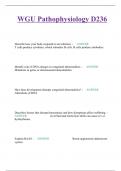
-
WGU Pathophysiology D236
- Exam (elaborations) • 31 pages • 2023
-
- $10.49
- + learn more
WGU Pathophysiology D236 Describe how your body responds to an infection. - ANSWER T cells produce cytokines, which stimulate B cells. B cells produce antibodies. Identify role of DNA changes in congenital abnormalities. - ANSWER Mutations in genes or chromosomal abnormalities How does development disrupts congenital abnormalities? - ANSWER Alterations of D...
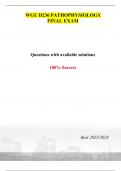
-
WGU D236 PATHOPHYSIOLOGY FINAL EXAM | (Graded 97%) Q&A | 100% Success Best 2023/2024
- Exam (elaborations) • 32 pages • 2024
- Available in package deal
-
- $25.99
- + learn more
Describe how your body responds to an infection. correct answer T cells produce cytokines, which stimulate B cells. B cells produce antibodies. Identify role of DNA changes in congenital abnormalities. correct answer Mutations in genes or chromosomal abnormalities How does development disrupts congenital abnormalities? correct answer Alterations of DNA Describes factors that disrupt homeostasis and how disruptions affect wellbeing. correct answer (ex) Fluid and electrolyte shifts can caus...
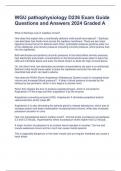
-
WGU pathophysiology D236 Exam Guide Questions and Answers 2024 Graded A
- Exam (elaborations) • 32 pages • 2024
- Available in package deal
-
- $14.49
- + learn more
What is Starling's Law of Capillary forces? How does this explain why a nutritionally deficient child would have edema? - Starling's Law describes how fluids move across the capillary membrane. There are two major opposing forces that act to balance each other, hydrostatic pressure (pushing water out of the capillaries) and osmotic pressure (including oncontic pressure, which pushes fluid into the capillaries). Both electrolytes and proteins (oncontic pressure) in the blood affect osmo...
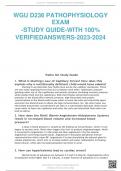
-
WGU D236 PATHOPHYSIOLOGY EXAM -STUDY GUIDE-WITH 100% VERIFIEDANSWERS-2023-2024
- Exam (elaborations) • 28 pages • 2024
- Available in package deal
-
- $13.99
- + learn more
WGU D236 PATHOPHYSIOLOGY EXAM -STUDY GUIDE-WITH 100% VERIFIEDANSWERS- Patho OA Study Guide 1. What is Starling's Law of Capillary forces? How does this explain why a nutritionally deficient child would have edema? Starling’s Law describes how fluids move across the capillary membrane. There are two major opposing forces that act to balance each other, hydrostatic pressure (pushing water out of the capillaries) and osmotic pressure (including oncontic pressure, which pushes fluid i...
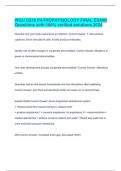
-
WGU D236 PATHOPHYSIOLOGY FINAL EXAM| Questions with 100% verified solutions 2024
- Exam (elaborations) • 24 pages • 2024
-
- $10.48
- + learn more
WGU D236 PATHOPHYSIOLOGY FINAL EXAM| Questions with 100% verified solutions 2024 Describe how your body responds to an infection. Correct Answer: T cells produce cytokines, which stimulate B cells. B cells produce antibodies. Identify role of DNA changes in congenital abnormalities. Correct Answer: Mutations in genes or chromosomal abnormalities How does development disrupts congenital abnormalities? Correct Answer: Alterations of DNA Describes factors that disrupt homeostasis and how ...
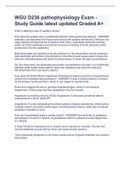
-
WGU D236 pathophysiology Exam -Study Guide latest updated Graded A+
- Exam (elaborations) • 32 pages • 2022
-
- $12.99
- 2x sold
- + learn more
What is Starling's Law of Capillary forces? How does this explain why a nutritionally deficient child would have edema? - ANSWER Starling's Law describes how fluids move across the capillary membrane. There are two major opposing forces that act to balance each other, hydrostatic pressure (pushing water out of the capillaries) and osmotic pressure (including oncontic pressure, which pushes fluid into the capillaries). Both electrolytes and proteins (oncontic pressure) in the blood affe...

-
WGU D236 Pathophysiology Latest Update 2023.
- Exam (elaborations) • 16 pages • 2023
- Available in package deal
-
- $14.49
- 1x sold
- + learn more
WGU Pathophysiology D236 Latest Update 2023 Describe how your body responds to an infection. - Correct answer-T cells produce cytokines, which stimulate B cells. B cells produce antibodies. Identify role of DNA changes in congenital abnormalities. - Correct answer-Mutations in genes or chromosomal abnormalities How does development disrupts congenital abnormalities? - Correct answer-Alterations of DNA Describes factors that disrupt homeostasis and how disruptions aff...
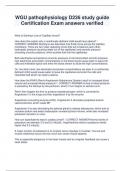
-
WGU pathophysiology D236 study guide Certification Exam answers verified
- Exam (elaborations) • 33 pages • 2024
- Available in package deal
-
- $17.99
- + learn more
WGU pathophysiology D236 study guide Certification Exam answers verified What is Starling's Law of Capillary forces? How does this explain why a nutritionally deficient child would have edema? - CORRECT ANSWER-Starling's Law describes how fluids move across the capillary membrane. There are two major opposing forces that act to balance each other, hydrostatic pressure (pushing water out of the capillaries) and osmotic pressure (including oncontic pressure, which pushes fluid into th...
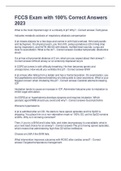
-
FCCS Exam with 100% Correct Answers 2023
- Exam (elaborations) • 7 pages • 2023
- Available in package deal
-
- $11.89
- 2x sold
- + learn more
What is the most important sign in a critically ill pt? Why? - Correct answer-Tachypnea Indicates metabolic acidosis w/ respiratory alkalosis compensation A pt misses dialysis for a few days and comes in with fluid overload. He's tachycardic and tachypneic. On physical exam, you find JVD, pulsus paradoxus (20 mmHg drop during inspiration), and HoTN (80/40) with distant, muffled heart sounds. Lungs are clear to auscultation. What is the dx? - Correct answer-Cardiac tamponade; obstructive s...
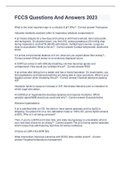
-
FCCS Questions And Answers 2023
- Exam (elaborations) • 34 pages • 2023
- Available in package deal
-
- $10.99
- 1x sold
- + learn more
What is the most important sign in a critically ill pt? Why? - Correct answer-Tachypnea Indicates metabolic acidosis (often w/ respiratory alkalosis compensation) A pt misses dialysis for a few days and comes in with fluid overload. He's tachycardic and tachypneic. On physical exam, you find JVD, pulsus paradoxus (20 mmHg drop during inspiration), and HoTN (80/40) with distant, muffled heart sounds. Lungs are clear to auscultation. What is the dx? - Correct answer-Cardiac tamponade; obstru...

How much did you already spend on Stuvia? Imagine there are plenty more of you out there paying for study notes, but this time YOU are the seller. Ka-ching! Discover all about earning on Stuvia


